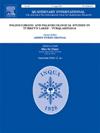Response of sensitive grain size components in the muddy area off the southern coast of Weihai city, China, to Holocene climate and environmental changes
IF 1.9
3区 地球科学
Q3 GEOGRAPHY, PHYSICAL
引用次数: 0
Abstract
Studying marine sediment is crucial for understanding the processes and mechanisms of Holocene climate and environmental changes. In this study, we analyzed the grain size distribution of the sediments from WHZK01 Core (0–14.95 m) in the muddy area off the southern coast of Weihai city, and extracted the sensitive grain size (SGS) using the grain size-standard deviation method, to further analyse the sediment transport mechanism since the Holocene and its significance as an environmental indicator in the climate change. The results show that the sediments in WHZK01 Core is mainly composed of silt and clayey silt, with poor sorting and a positive skewness, and primarily transported by suspension and saltation. We identified three SGSs: SGS 1 (<15.63 μm), SGS 2 (15.63 μm–148.65 μm), and SGS 3 (>148.65 μm), corresponding to the fine, medium, and coarse components of the sediment, respectively. Among them, SGS 2 exhibits a strong correlation with events of intensified East Asian winter monsoon(EAWM). Based on the variations in this grain size fraction, eight prominent EAWM intensification events over the past ∼11,000 years (Holocene) were identified: 8100–7600 a BP, 6300–6000 a BP, 5500–5050 a BP, 4600–4200 a BP, 4100–3600 a BP, 2850–2400 a BP, 1900–1500 a BP and 700-175 a BP, which are good indicators of palaeoclimatic environmental changes.
威海南海岸泥质区敏感粒度组分对全新世气候环境变化的响应
研究海洋沉积物对于理解全新世气候环境变化的过程和机制具有重要意义。本文通过对威海市南岸浑浊区WHZK01岩心(0 ~ 14.95 m)沉积物粒度分布特征的分析,利用粒度-标准差法提取敏感粒度(SGS),进一步分析全新世以来的沉积物输运机制及其作为气候变化环境指标的意义。结果表明:WHZK01岩心沉积物以粉砂质和粘质粉砂为主,分选差,偏度正,以悬浮和跃移为主;我们确定了三个SGSs: SGS 1 (<15.63 μm), SGS 2 (>148.65 μm)和SGS 3 (>148.65 μm),分别对应于沉积物的细、中、粗组分。其中,SGS 2与东亚冬季风(EAWM)增强事件具有较强的相关性。在此基础上,确定了8100 ~ 7600 a BP、6300 ~ 6000 a BP、5500 ~ 5050 a BP、4600 ~ 4200 a BP、4100 ~ 3600 a BP、2850 ~ 2400 a BP、1900 ~ 1500 a BP和700 ~ 175 a BP这8个全新世EAWM强化事件,是古气候环境变化的良好指标。
本文章由计算机程序翻译,如有差异,请以英文原文为准。
求助全文
约1分钟内获得全文
求助全文
来源期刊

Quaternary International
地学-地球科学综合
CiteScore
5.60
自引率
4.50%
发文量
336
审稿时长
3 months
期刊介绍:
Quaternary International is the official journal of the International Union for Quaternary Research. The objectives are to publish a high quality scientific journal under the auspices of the premier Quaternary association that reflects the interdisciplinary nature of INQUA and records recent advances in Quaternary science that appeal to a wide audience.
This series will encompass all the full spectrum of the physical and natural sciences that are commonly employed in solving Quaternary problems. The policy is to publish peer refereed collected research papers from symposia, workshops and meetings sponsored by INQUA. In addition, other organizations may request publication of their collected works pertaining to the Quaternary.
 求助内容:
求助内容: 应助结果提醒方式:
应助结果提醒方式:


